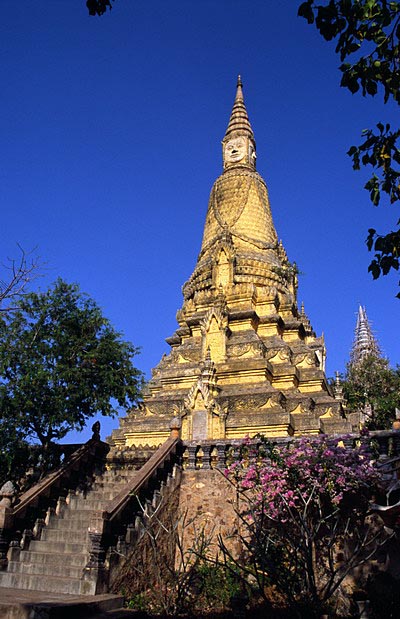Oudong Meanchey Province on:
[Wikipedia]
[Google]
[Amazon]
Oudong ( km, ឧដុង្គ; also romanized as Udong or Odong) is a former town of the post-Angkorian period (1618–1863) situated in present-day ''Phsar Daek'' Commune, Ponhea Lueu District, Kandal Province, Cambodia. Located at the foothill of the mountain Phnom Oudong, also known as Phnom Preah Reach Troap ( km, ភ្នំព្រះរាជ្យទ្រព្យ), about 35 km northwest of the modern capital
 The city's name is derived from the Sanskrit word "" ( sa, उत्तुङ्ग), meaning tall, which probably refers to the mountain. As it had gained religious merit and significance it might have undergone extension towards: "great" or "supreme".
The city's name is derived from the Sanskrit word "" ( sa, उत्तुङ्ग), meaning tall, which probably refers to the mountain. As it had gained religious merit and significance it might have undergone extension towards: "great" or "supreme".
Site d'Oudong - UNESCO World Heritage Centre
/ref> The submission has been renewed on 27 March 2020.
Brief History of Oudong
{{coord, 11, 49, 26, N, 104, 44, 33, E, region:KH_type:city, display=title Towns in Cambodia Populated places in Kandal province Archaeological sites in Cambodia Buddhist temples in Cambodia
Phnom Penh
Phnom Penh (; km, ភ្នំពេញ, ) is the capital and most populous city of Cambodia. It has been the national capital since the French protectorate of Cambodia and has grown to become the nation's primate city and its economic, indus ...
via National Road No. 5, Oudong was a royal residence and Cambodia's capital for almost 250 years until 1866. A monumental royal necropolis of sovereigns of several centuries is scattered on top of the prominent bisected mountain, which runs from the southeast to the northeast.
Etymology
 The city's name is derived from the Sanskrit word "" ( sa, उत्तुङ्ग), meaning tall, which probably refers to the mountain. As it had gained religious merit and significance it might have undergone extension towards: "great" or "supreme".
The city's name is derived from the Sanskrit word "" ( sa, उत्तुङ्ग), meaning tall, which probably refers to the mountain. As it had gained religious merit and significance it might have undergone extension towards: "great" or "supreme".
History
Oudong was founded by KingSrei Soryapor
Barom Reachea IV or Barom Reachea VII (1548–1619), also known as Srei Soriyopear (also spelled Soryopor or Soryapor; km, ស្រីសុរិយោពណ៌), was the Cambodian king who ruled from 1603 to 1618.
He was appointed the '' ...
in 1601, after the abandonment of Longvek
Longvek or Lavek ( km, លង្វែក, or , ; meaning "intersection" or "crossroads") was a city in Cambodia. It was the second capital city during the Cambodia's Post-Angkor period which began after the Angkor era. The city was known to ear ...
. Under the reign of King Ang Duong (1841–1850), he constructed canals, terraces, bridges and erected hundreds of pagodas in this region.
From 1618 until 1866 it was formally called Oudong Meanchey, home to a succession of kings deposed from the former capital of Longvek by the invading Thais. In 1866, it was abandoned by King Norodom
Norodom ( km, នរោត្តម, ; born Ang Voddey ( km, អង្គវតី, ); 3 February 1834 – 24 April 1904) was Monarchy of Cambodia, King of Cambodia from 19 October 1860 to his death on 24 April 1904. He was the eldest son of ...
, taking his royal court along with him to the current capital, Phnom Penh.
During the Cambodian Civil War the town was captured by the Khmer Rouge
The Khmer Rouge (; ; km, ខ្មែរក្រហម, ; ) is the name that was popularly given to members of the Communist Party of Kampuchea (CPK) and by extension to the regime through which the CPK ruled Cambodia between 1975 and 1979. ...
in March 1974, who marched the citizens into the countryside, as well as executing a large number of prisoners. This proved to be a trial-run for the evacuation of Phnom Penh a year later. The Government retook the town in August the same year, but evidence of atrocities was widely discarded by international journalists.
It was extensively damaged by the Khmer Rouge
The Khmer Rouge (; ; km, ខ្មែរក្រហម, ; ) is the name that was popularly given to members of the Communist Party of Kampuchea (CPK) and by extension to the regime through which the CPK ruled Cambodia between 1975 and 1979. ...
in 1977, along with the other temples, monuments and religious structures there.
Folklore
Legend has it that in the Arthaross Temple (Temple of Eighteen Points, from pi, अट्ठारस , eighteen ), the Buddha located here faces north instead of the traditional direction of east, symbolizing a testimony to the strength and power of the ancient Khmer kingdom. Henri Mouhot: "Travels in the Central Parts of Indo-China" 1864:World Heritage Status
This site was originally added to the UNESCO World Heritage Tentative List on 1 September 1992, in the Cultural category./ref> The submission has been renewed on 27 March 2020.
See also
* Post-Angkor period * History of CambodiaReferences
Sources
* "The Rough Guide Southeast Asia" Rough Guides, 2002External links
Brief History of Oudong
{{coord, 11, 49, 26, N, 104, 44, 33, E, region:KH_type:city, display=title Towns in Cambodia Populated places in Kandal province Archaeological sites in Cambodia Buddhist temples in Cambodia